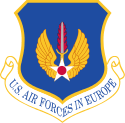RAF Akrotiri
| RAF Akrotiri | |||||||
|---|---|---|---|---|---|---|---|
| "Aki" | |||||||
| Near Limassol in Cyprus | |||||||
 | |||||||
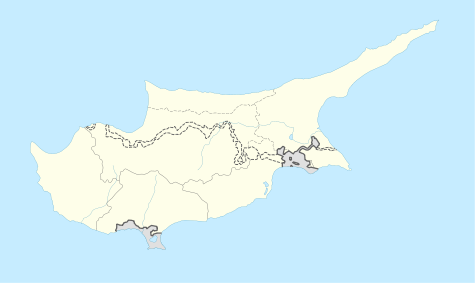 LCRA Shown within Cyprus | |||||||
| Coordinates | 34°35′26″N 032°59′16″E / 34.59056°N 32.98778°ECoordinates: 34°35′26″N 032°59′16″E / 34.59056°N 32.98778°E | ||||||
| Type | Royal Air Force station | ||||||
| Site information | |||||||
| Owner | Ministry of Defence | ||||||
| Operator | Royal Air Force | ||||||
| Site history | |||||||
| Built | 1950 | ||||||
| In use | 1950–present | ||||||
| Garrison information | |||||||
| Current commander |
Group Captain P D Kennett MA RAF[1] | ||||||
| Occupants | No. 84 Squadron RAF | ||||||
| Airfield information | |||||||
| Identifiers | IATA: AKT, ICAO: LCRA | ||||||
| Elevation | 22 metres (72 ft) AMSL | ||||||
| |||||||
| Source: Cypriot AIP at EUROCONTROL[2] | |||||||
Royal Air Force Akrotiri or more simply RAF Akrotiri (IATA: AKT, ICAO: LCRA) is a large Royal Air Force station, on the Mediterranean island of Cyprus. It is located in the Western Sovereign Base Area, one of two areas which comprise Akrotiri and Dhekelia, a British Overseas Territory, administered as a Sovereign Base Area.
The station commander is double-hatted and is also the officer commanding the Akrotiri or Western Sovereign Base Area, reporting to the commander of British Forces Cyprus who is also the Administrator.
History
The Beginning
Akrotiri was first constructed in the mid-1950s to relieve pressure on the main RAF station on the island, RAF Nicosia. In the aftermath of the Egyptian repudiation of the Anglo-Egyptian treaty, British forces had to be withdrawn from the Canal Zone in Egypt. After the ending of the League of Nations mandate over Palestine in 1948, the only other British territory in the eastern Mediterranean was Cyprus. Consequently, the withdrawal from Egypt resulted in an enormous build-up of forces in Cyprus. This period also coincided with the outbreak of the internal security problems of EOKA in Cyprus, further increasing pressure on the RAF airfields on the island.
Suez Crisis
Even this massive influx from Egypt was not the end. In late 1956, relations between the United Kingdom and Egypt had reached crisis point. The Suez Crisis saw a further increase in the strength of RAF forces in Cyprus. Akrotiri was mainly an airfield for fighter, photo reconnaissance and ground attack aircraft. Its regular squadrons of Meteor night fighters, Canberra photo reconnaissance aircraft and Venom ground attack machines were reinforced by further Canberras and Hunters from Fighter Command in the United Kingdom. The airfields in Cyprus were so overcrowded that there was a real fear of massive loss of equipment should the Egyptian Air Force decide to attack the island. Fortunately for the RAF, that attack never came. The overcrowding extended beyond Cyprus. Significant RAF units from Bomber Command were deployed to RAF Luqa in Malta, crowding that station as well.
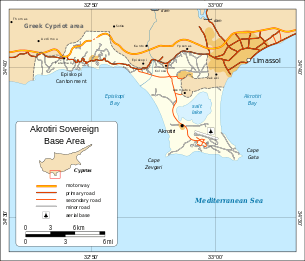
The attack on Egypt was a military success, despite interference in the plan which reduced its effectiveness. However, it was a political fiasco, because the United States put considerable pressure on the United Kingdom and France both economically and politically. This quickly forced the Eden government from power. The station's complement quickly returned to normal after the crisis passed, with the reinforcing units that had crowded it during the war returning either to the United Kingdom or to other parts of the Middle East Command.
1960s
After the Suez Crisis, the main emphasis of life on the airfield shifted to helping quell the EOKA revolt and training missions. After the withdrawal from both Egypt and Iraq, and débâcle of Suez, it was clear that a command centred on Cyprus could not control units stationed in the Arabian Peninsula, of which there were still many. Consequently, the Middle East Command was split, with that east of Suez being controlled from Aden, and the rump being renamed the Near East Command, controlled from Cyprus. From 1957 to 1969, four squadrons of Canberras (Nos 6, 32, 73, and 249) provided first a conventional and then from November 1961, a nuclear striking capability as part of the Baghdad Pact, later CENTO.[3]
Akrotiri, along with Nicosia, assumed a very important status, as virtually the sole means for projecting British airpower into the eastern Mediterranean, outside of aircraft carriers. In 1960, independence was granted to Cyprus, with the RAF maintaining both RAF Nicosia and RAF Akrotiri as airfields, controlled by the Near East Air Force. However, Akrotiri assumed more and more importance as Nicosia was used for greater and greater amounts of civil aviation traffic. After 1966, it was no longer possible to maintain RAF units at Nicosia due to pressures of space, and Akrotiri became the only RAF flying station left on the island.
1970s
In August 1970 a detachment of "G" of the Central Intelligence Agency arrived at the airfield with U-2 aircraft to monitor the Egypt/Israel Suez Canal fighting and cease fire. Later permanent monitoring of Middle East Ceasefire after 1973 Yom Kippur War. It became the 100th Strategic Reconnaissance Wing OL "Olive Harvest" in 1974.[4]
Up until 1974 RAF Akrotiri had a balanced force of aircraft assigned to it, including No. 9 Squadron RAF and No. 35 Squadron RAF flying Vulcans. The Vulcans provided a bomber force for the Central Treaty Organisation, one of the three great anti-Communist mutual defence pacts signed in the early days of the Cold War.[5] However, during that year, Turkish forces invaded Cyprus in connection with a Greek-sponsored coup. The UK then evacuated most of the RAF from Akrotiri as the CENTO treaty had degenerated to the point of uselessness. The two Vulcan squadrons left for UK stations in 1975. What was left at the airfield was the flying unit that is permanently assigned to the station to this day; No. 84 Squadron RAF, a search and rescue unit flying helicopters.[6] In addition the role of No. 34 Squadron RAF Regiment was changed from Low level Air Defence to infantry and counter terrorist duties.
In September 1976 the US U-2 operations were turned over to the 9th Strategic Reconnaissance Wing, but the U-2 operation at RAF Akrotiri continued to be called Operating Location OH until September 1980. Thereafter it became Detachment 3 of the 9th SRW, although the name OLIVE HARVEST continues. Two U-2s are stationed at RAF Akrotiri and they are still monitoring the ceasefire agreement between the Egypt and Israel although the present operations in Central Command requires further missions. U-2s also transit through RAF Akrotiri either on going into the Central Command theatre or returning to Beale AFB.
1980s
Between April 1983 and September 1984 RAF Chinooks deployed here to support British UN Forces in Lebanon.[7]
In the mid-1980s, the US launched retaliatory attacks against Libya after the country's leader, Muammar al-Gaddafi, was implicated in terrorist attacks against US military bases. Although the bombers were staged out of the United Kingdom, RAF Akrotiri was employed in the role of an alternate in case of emergency, and was used as such by at least one aircraft. This caused a severe upgrade in security around the airfield as Libya threatened to respond against locations used in staging the attacks. The threat was carried through with an attack on the station on 3 August 1986 with mortars, rocket-propelled grenades and small arms. Three British dependants were wounded although damage was negligible. Security at the station remained high with substantial fortifications constructed along its northern perimeter, until the first Gulf War. The attack was carried out by an unknown supposed Palestinian group but it was generally assumed that this was commissioned and underwritten by Libya.
2010s
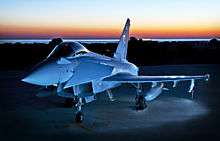
In July 2006 RAF Akrotiri played a major role as a transit point for personnel evacuations out of Lebanon during the 2006 Lebanon War (see International reactions to the 2006 Lebanon War and Joint Task Force Lebanon).
Akrotiri was the location of the main transmitter of the well known numbers station, the Lincolnshire Poacher, although transmissions ceased in 2008.
In March 2011, the station was used as a staging base for support aircraft involved in Operation Ellamy. Tanker support and logistical units were based here to support aerial operations over Libya.[8] In August 2013, six RAF Typhoon Fighters were deployed to Akrotiri to defend the base, following possible military responses to an alleged Syrian government chemical weapons attack. Earlier two Tristar air-to-air refuelling aircraft and a Sentry AEW.1 had been deployed to Akrotiri.[9][10]
The station hosted the main hospital for British Forces Cyprus, The Princess Mary's Hospital (TPMH), located on Cape Zevgari. This closed in November 2012 and cases too serious to be dealt with at the base health clinic are sent to the private Ygia Polyclinic in Limassol.
In August 2014, six RAF Tornado fighter/bombers were deployed to Akrotiri to carry out reconnaissance missions over Iraq, following the rise of Islamic State in Iraq and Syria. On September 26, 2014, MPs voted in favour of the RAF carrying out air strikes on ISIS in Iraq, and on 27 September the first two Tornado jets took off from Akrotiri loaded with laser guided bombs and missiles. On 30 September 2014, two RAF British Tornados successfully attacked and intercepted ISIS targets of a heavily armed truck, at the request of Iraqi Kurdish fighters.[11][12]
Recent operations and issues

Akrotiri has played a crucial role during Britain's recent operations in the Middle East. During both major campaigns against Iraq, in 1991 and 2003, and also during the no-fly zone operations between, it operated as a staging post for British forces en route to the region.
A constant problem of airfields located outside the territory of the country whose forces are based there is that of overflight rights. The UK has a treaty with Cyprus that guarantees British access to Akrotiri in any circumstances. Under the treaty, the stations employ many locals and contribute to the local economy.
A sizeable over-the-horizon radar antenna was erected within the base raising concern for the effect on local wildlife and on the health of people living in nearby Limassol. Several demonstrations and protests took place, with most memorable incident the act of MP (MEP since 2004) Marios Matsakis to chain himself on the antenna. Amateur radio operators report that the radar is causing interference in bands allocated for amateur radio use by the ITU. From the international amateur radio union region 1 monitoring system news letter (April 2002): The lowest frequency was 18000 kHz, the highest frequency so far during the current solar cycle is 30500 kHz. The bandwidth is normally 50 to 60 kHz, the signal strength S9 + 70 dB thus causing very harmful interference to the Amateur Radio Service.
Akrotiri is also the location of the Limassol BBC Relay that broadcast the BBC World Service radio signal to the Middle East.
Due to the station's relative proximity to the Middle East, it is often used by British allies when needed, such as for casualty reception for Americans after the 1983 Beirut barracks bombing[13] and as a staging post before heading into theatres of combat in the Middle East/Persian Gulf theaters.
The U-2s of the 9th Reconnaissance Wing were used in Operation Cedar Sweep to fly surveillance over Lebanon, relaying information about Hezbollah militants to Lebanese authorities, and in Operation Highland Warrior to fly surveillance over Turkey and northern Iraq to relay information to Turkish authorities. These flights were the topic of acrimonious diplomatic cables between British officials and the American embassy, later leaked by Wikileaks, with David Miliband saying that "policymakers needed to get control of the military". The British were concerned that the flights over Lebanon were authorised by the Lebanese Ministry of Defence rather than the entire cabinet, and that the intelligence so gained could lead to the UK being complicit in the unlawful torture of detainees. After warnings that these issues "could jeopardize future use of British territory", John Rood, a senior Bush administration official, and Mariot Leslie, the Foreign Office's director general for defence and intelligence, became involved. Leslie said that the U.S. was not actually expected to check on detained terrorists, but that future spy missions would require full written applications.[14][15]

Akrotiri is also the winter training grounds of the RAF display team, the Red Arrows.
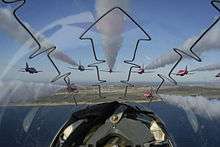
Structure
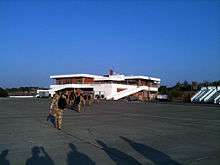
- No. 84 Squadron RAF with Bell Griffin HAR.2's.
- 3 Platoon, Cyprus Joint Police Unit CJPU – Akrotiri
- Support Wing
- Operation Wing
- Operation Shader (Anti ISIL operations)
- Detachment of 10 x Panavia Tornado GR.4 from RAF Marham[16]
- Detachment of 9 x Eurofighter Typhoon FGR.4 from RAF Lossiemouth[16]
- Detachment of 2 x Boeing Sentry AEW.1[17]
- Detachment of 2 x Raytheon Sentinel R.1[18]
- Detachment of 1 x Airbus Voyager KC.2/3[16]
- Detachment of 1 x Airbus Atlas C.1[16]
- Detachment of 1 x Lockheed Hercules C.5[19]
- Detachment of 1 x Boeing C-17A Globemaster III[20]
- Detachment of 1 x Beechcraft Shadow R.1[21]
Airline and destination
| Airlines | Destinations |
|---|---|
| Royal Air Force operated by AirTanker | RAF Brize Norton |
See also
| Wikimedia Commons has media related to RAF Akrotiri. |
References
Citations
- ↑ "Welcome to RAF Akrotiri". Royal Air Force. Retrieved 22 July 2015.
- ↑ "EAD Basic - Error Page". Retrieved 3 December 2015.
- ↑ Lee, 1989, 172-176.
- ↑ "RAF Akrotiri". Hansard. UK Parliament. 15 June 1990. HC Deb 15 June 1990 vol 174 c380W. Retrieved 19 August 2013.
- ↑ See David Lee, Wings in the Sun: A History of the Royal Air Force in the Mediterranean 1945-1986, HMSO Books 1989
- ↑ No. 84 Squadron RAF
- ↑ Cotter 2008, p. 71.
- ↑ "Updated: Second UK strike against Libyan defence assets". Retrieved 3 December 2015.
- ↑ Ben Rankin (29 August 2013). "Syria: RAF Typhoon jets sent to Cyprus". mirror. Retrieved 3 December 2015.
- ↑ "Typhoons deploying to Cyprus". Retrieved 3 December 2015.
- ↑ "RAF planes bomb Islamic State targets in Iraq for the first time". The Guardian.
- ↑ "RAF jets sent on Iraqi combat mission". BBC News.
- ↑ "Report of the DoD Commission on Beirut Int'l Airport Terrorist Act, October 23, 1983--Part Eight". Retrieved 3 December 2015.
- ↑ Richard Norton-Taylor and David Leigh (2010-12-01). "UK overruled on Lebanon spy flights from Cyprus, WikiLeaks cables reveal". The Guardian.
- ↑ "Viewing cable 08LONDON1350, HMG RAISES THE BAR ON INTEL FLIGHTS". Wikileaks. 2010-12-02.
- 1 2 3 4 AirForces Monthly. Stamford, Lincolnshire, England: Key Publishing Ltd. January 2016. p. 4.
- ↑ "The E-3D Sentry Arrives in RAF Akrotiri". Forces TV. Retrieved 16 December 2015.
- ↑ "UK troops to train moderate Syrian opposition". Ministry of Defence. Retrieved 16 December 2015.
- ↑ AirForces Monthly. Stamford, Lincolnshire, England: Key Publishing Ltd. February 2015. p. 5.
- ↑ "RAF Delivers Military Support to Iraq". Royal Air Force. Retrieved 16 December. Check date values in:
|access-date=(help) - ↑ "RAF steps up Iraq and Syria spying missions in 'new Battle of Britain'". The Guardian. Retrieved 19 July 2015.
Bibliography
- Cotter, J (2008). Royal Air Force celebrating 90 years. Stamford, UK: Key Publishing Ltd. ISBN 978-0-946219-11-7.
- David Lee, Wings in the Sun: A history of the Royal Air Force in the Mediterranean 1945–1986, HMSO Books 1989
External links
- Official website
- Royal Air Force overseas stations – official website
- A website with personal memories of the RAF station by former airmen (and sailors and soldiers)
- A virtual tour of RAF Akrotiri
- History and information about The Princess Mary's Hospital

